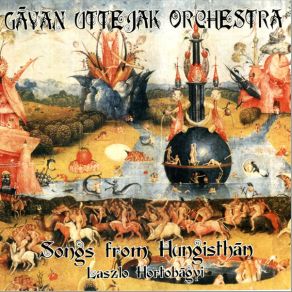Songs from Hungisthan
Download links and information about Songs from Hungisthan by László Hortobágyi - Gáyan Uttejak Orchestra / Laszlo Hortobagyi - Gayan Uttejak Orchestra. This album was released in 1905 and it belongs to New Age, Electronica, Trance, Dancefloor, World Music, Dance Pop genres. It contains 12 tracks with total duration of 01:08:38 minutes.

|
|
|---|---|
| Artist: | László Hortobágyi - Gáyan Uttejak Orchestra / Laszlo Hortobagyi - Gayan Uttejak Orchestra |
| Release date: | 1905 |
| Genre: | New Age, Electronica, Trance, Dancefloor, World Music, Dance Pop |
| Tracks: | 12 |
| Duration: | 01:08:38 |
| Buy it NOW at: | |
| Buy on iTunes $9.99 | |
Tracks
[Edit]| No. | Title | Length |
|---|---|---|
| 1. | Introvertigo (Introversion) | 3:53 |
| 2. | Ghazal-femalla (Psalmus-morpheus) | 8:37 |
| 3. | Harmonogram (Trans-nái-verse) | 3:54 |
| 4. | Ajam-hayrani (Planctus-bayáti) | 4:55 |
| 5. | Tablá-rasa (Ex-saltatio) | 4:29 |
| 6. | Nóhgaku-súra (Koan-orphicus) | 5:13 |
| 7. | Carnátic-masque (Thanam-baroque-pallavi) | 6:42 |
| 8. | Ab-fatum (Hunnia-teurgica) | 3:50 |
| 9. | Súfi-manna (Gíta-dhrupada) | 6:08 |
| 10. | Segah-mithra (Trance-maqám) | 6:47 |
| 11. | Nava-morphilla (Shárqi Acid-choral) | 5:42 |
| 12. | Necro-logos (Annihilament) | 8:28 |
Details
[Edit]Songs from Hungisthãn was the Gayan Uttejak Orchestra's first album for Suns of Arqa's label, Arka Sound. A previous version (with different track titles) had come out on a small Hungarian label in 1996. The sound world fabricated by Lászlo Hortobágyi is fascinating but also slightly irritating — at least to the ear trained in Eastern classical music. The man uses an extensive library of authentic ethnic music to draw tiny samples of voices and instruments to piece together fantasy world music presented as the genuine tradition of Hungisthãn, a country that, if it existed, would be squeezed between Hungary, Armenia, Iran, and India. Where Roberto Musci and Giovani Venosta used to construct songs out of melodies and rhythms lifted from unrelated traditions, Hortobágyi goes into smaller details to piece together new melodies and rhythms from microscopic shards (some samples are only 20 milliseconds long!), giving them their own "cultural" identity — and backs up the results with ethereal synthesizers and trance beats. The results are nothing short of stunning, sounding strange but highly credible. What he does to classical forms like the nai, the raga, and the maqam will send purists screaming for mercy, but on a lighter level it works. The album is conceived as a single hourlong listen, tracks seguing into each other, with some voices and motifs reappearing in different places. The gripping melodies of "Ghazal-femalla," the Sufi chant reworkings in "Sufi-manna," and the delicate requiem "Necro-logos" stand out (although the techno-tribal beat in the second half of the latter piece comes in a bit too late to be welcome). Hortobágyi gives the expression "ethnic fusion" a meaning it wasn't meant to have. ~ François Couture, Rovi